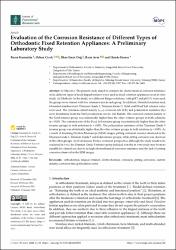| dc.contributor.author | Kumrular, Buşra | |
| dc.contributor.author | Çiçek, Orhan | |
| dc.contributor.author | Dağ, İlker Emin | |
| dc.contributor.author | Avar, Barış | |
| dc.contributor.author | Erener, Hande | |
| dc.date.accessioned | 2023-05-06T17:20:47Z | |
| dc.date.available | 2023-05-06T17:20:47Z | |
| dc.date.issued | 2023 | |
| dc.identifier.issn | 2079-4983 | |
| dc.identifier.uri | https://doi.org/10.3390/jfb14020081 | |
| dc.identifier.uri | https://hdl.handle.net/20.500.11776/11935 | |
| dc.description.abstract | (i) Objective: The present study aimed to compare the electrochemical corrosion resistance of six different types of fixed lingual retainer wires used as fixed retention appliances in an in vitro study. (ii) Methods: In the study, two different Ringer solutions, with pH 7 and pH 3.5, were used. Six groups were formed with five retainer wires in each group. In addition, 3-braided stainless steel, 6-braided stainless steel, Titanium Grade 1, Titanium Grade 5, Gold, and Dead Soft retainer wires were used. The corrosion current density (i(corr)), corrosion rate (CR), and polarization resistance (R-p) were determined from the Tafel polarization curves. (iii) Results: The corrosion current density of the Gold retainer group was statistically higher than the other retainer groups in both solutions (p < 0.05). The corrosion rate of the Dead Soft retainer group was statistically higher than the other retainer groups in both solutions (p < 0.05). The polarization resistance of the Titanium Grade 5 retainer group was statistically higher than the other retainer groups in both solutions (p < 0.05). As a result of Scanning Electron Microscope (SEM) images, pitting corrosion was not observed in the Titanium Grade 1, Titanium Grade 5 and Gold retainer groups, while pitting corrosion was observed in the other groups. (iv) Conclusion: From a corrosion perspective, although the study needs to be evaluated in vivo, the Titanium Grade 5 retainer group included is in this in vitro study may be more suitable for clinical use due to its high electrochemical corrosion resistance and the lack of pitting corrosion observed in the SEM images. | en_US |
| dc.language.iso | eng | en_US |
| dc.publisher | Mdpi | en_US |
| dc.identifier.doi | 10.3390/jfb14020081 | |
| dc.rights | info:eu-repo/semantics/openAccess | en_US |
| dc.subject | orthodontics | en_US |
| dc.subject | lingual retainer | en_US |
| dc.subject | electrochemical corrosion | en_US |
| dc.subject | pitting corrosion | en_US |
| dc.subject | current density | en_US |
| dc.subject | corrosion rate | en_US |
| dc.subject | polarization curve | en_US |
| dc.subject | Stainless-Steel | en_US |
| dc.subject | Artificial Saliva | en_US |
| dc.subject | In-Vitro | en_US |
| dc.subject | Ion Release | en_US |
| dc.subject | Behavior | en_US |
| dc.subject | Archwires | en_US |
| dc.subject | Fluoride | en_US |
| dc.subject | Wires | en_US |
| dc.subject | Brackets | en_US |
| dc.subject | Niti | en_US |
| dc.title | Evaluation of the Corrosion Resistance of Different Types of Orthodontic Fixed Retention Appliances: A Preliminary Laboratory Study | en_US |
| dc.type | article | en_US |
| dc.relation.ispartof | Journal Of Functional Biomaterials | en_US |
| dc.department | Fakülteler, Diş Hekimliği Fakültesi, Klinik Bilimler Bölümü | en_US |
| dc.authorid | Avar, Barış/0000-0002-6234-5448 | |
| dc.authorid | CICEK, Orhan/0000-0002-8172-6043 | |
| dc.authorid | DAG, ILKER EMIN/0000-0003-1116-9074 | |
| dc.identifier.volume | 14 | en_US |
| dc.identifier.issue | 2 | en_US |
| dc.institutionauthor | Erener, Hande | |
| dc.relation.publicationcategory | Makale - Uluslararası Hakemli Dergi - Kurum Öğretim Elemanı | en_US |
| dc.authorwosid | CICEK, Orhan/B-1629-2019 | |
| dc.identifier.wos | WOS:000939302700001 | en_US |
| dc.identifier.scopus | 2-s2.0-85148865135 | en_US |
| dc.identifier.pmid | 36826880 | en_US |



















